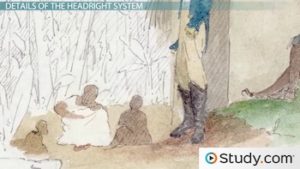
*The Headright Property System in America began on this date in 1618. A headright refers to a legal grant of land given to settlers during the European colonization of the Americas. Headright is most notable for its role in expanding the Thirteen Colonies; the Virginia Company gave headright to settlers, and the Plymouth Company followed. The headright system was used in several colonies, including Maryland, Georgia, North Carolina, and South Carolina. Most headright practices were for 1 to 1,000 acres (4.0 km2) of land and were granted to those willing to cross the Atlantic and help populate the colonies.
Headright practitioners were granted to anyone who would pay for the transportation costs of an indentured laborer. These land grants comprised 50 acres (0.20 km2) for someone newly moving to the area and 100 acres (0.40 km2) for people previously living there. By ensuring the landowning masters had legal ownership of all land acquired, the indentured laborers had little opportunity to procure their land after their indenture period had passed. This kept a large portion of the citizens of the Thirteen Colonies poor and led to tensions between the laborers and the landowners.
Slavery and the headright system
Plantation owners benefited from the headright system when they paid for the Middle Passage. This, and the increased amount of money required to bring indentured servants to the colonies, contributed to the shift toward chattel slavery. Until 1699, an enslaved person was worth a headright of fifty acres. According to records, in the 1670s, over 400 enslaved people were used as headrights in Virginia.
This number increased in the 1680s and 1690s. Many families gained power in the colonies by receiving large tracts of land when they imported enslaved people. For example, George Menefie purchased sixty enslaved people and received 3,000 acres in 1638. In 1699, it was decided that a headright would only be granted to free citizens and that transporting indentured laborers or slaves would no longer be a guarantor of land.
Issues with land patent records
According to records, there was a large discrepancy between the number of headrights issued and the number of new residents in the colonies. This gap may be explained by the high mortality rates of Blacks and the inhumane conditions they endured crossing the Atlantic Ocean to the colonies. Landowners would receive headrights for the dead; thus, the gap would widen between population growth and the number of headrights issued. Another explanation suggests that the secretary's office that issued the headrights grew laxer. There were few regulations in place to keep the headright system in check. Because of this, several headrights were claimed multiple times, and people took advantage of the lack of governance.
For instance, when a slave was brought to the colonies, the ship captain and the slave owner paying the transportation costs may have attempted to receive land patents or headrights for the same person. Another problem was that secretaries sometimes issued headrights to fictitious people. During the 1660s and 1670s, the number of headrights was about four times more than the increase in population. If this large discrepancy must be attributed to more than fictitious issuing, a final explanation suggests that people had accumulated and saved headrights. Headrights could be bought for about 50 pounds of tobacco each. The grant owners then claimed the land years later once the land had risen in value. Although keeping a count of the number of headrights issued may not lead to accurate estimations of population growth in the colonies, the number of patents issued indicates the demand for land.
Consequences of the headright system
In addition to leading to the distribution of too much land at the lax secretary's discretion, the headright system increased tensions between Indigenous tribes and the colonists. Indentured servants were granted land inland, regions that often bordered native tribes. This migration produced conflict between the natives and the slaves. Later, Bacon's Rebellion was sparked by tensions between the natives, settlers, and indentured servants. This headright system was a precursor to land redistribution after the American Civil War.